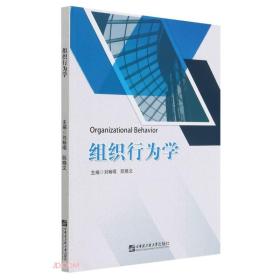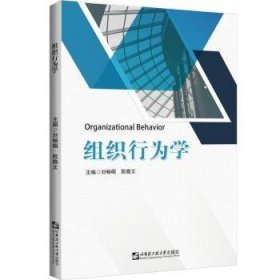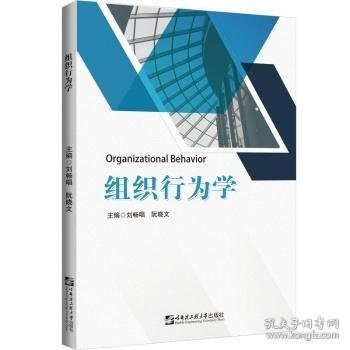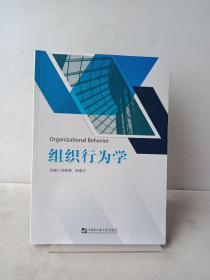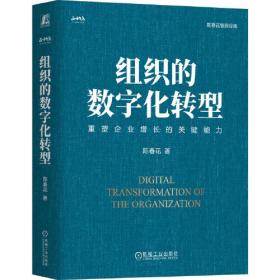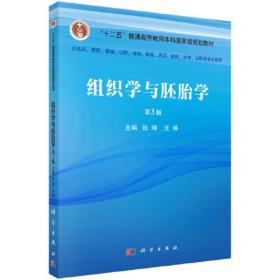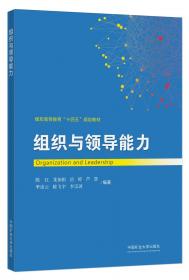组织行为学
出版时间:
2021-05
版次:
1
ISBN:
9787566130471
定价:
49.80
装帧:
平装
开本:
16开
页数:
212页
-
本书为江苏省2020年留学生全英文精品课程建设成果之一,全书分为6个部分,共12章。
部分是对组织行为学的整体概述,分别介绍了组织行为学的基本概念(章)、组织绩效和组织承诺(第二章)这两个组织很关心的内容。第二部分侧重探讨组织行为学关心的个体特征,包括个性、文化价值观和能力(第三章)。第三部分探讨影响个体工作结果的主要机制,包括动机(第四章),学习和决策制定(第五章)。第四部分探讨工作和组织特征,包括工作满意度(第六章),工作压力(第七章),信任、公正和伦理(第八章)。第五部分探讨群体机制,包括团队(第九章)和领导力(第十章)。第六部分讨论组织机制,包括组织结构(第十一章)和组织文化(第十二章)。
本书可作为高等院校留学生的全英文教学用书,也可作为广大高校组织行为学课程的双语教材使用,还可作为经济管理、人力资源管理、靠前商务从业人员的自学用书或培训用书。 Section I Introduction to Organizational Behavior
Chapter Explaining Organizational Behavior
1.1 Define organizational behavior(OB)
1.2 Describe the two primary outcomes in studies of OB
1.3 Identify the factors that influence the two primary OB outcomes
1.4 Understand why firms that are good at OB tend to be more profitable
1.5 Define theory and explain its role in the scientific method
1.6 Takeaways
1.7 Discussion questions
Chapter Performance and Commitment
2.1 Define job performance and organizational commitment
2.2 Define task performance and explain how organizations identify key task behaviors
2.3 Understand citizenship behavior, and describe some specific examples
2.4 Understand counterproductive behavior and describe some specific examples
2.5 Describe the three types of organizational commitment
2.6 Understand the four primary responses to negative events at work
2.7 Describe examples of psychological withdrawal and physical withdrawal, and explain how they relate to one another
2.8 Takeaways
2.9 Discussion questions
Section Ⅱ Individual Characteristics
Chapter 3 Personality, Cultural Values and Ability
3.1 Define personality, cultural values and ability
3.2 Understand the Big Five dimensions of personality
3.3 Understand Hofstede\'s dimensions of cultural values
3.4 Describe the dimensions of cognitive ability
3.5 Describe the dimensions of emotional ability
3.6 Understand how ability and personality affect job performance and organizational commitment
3.7 Takeaways
3.8 Discussion questions
Section Ⅲ Individual Mechanisms
Chapter 4 Motivation
4.1 Define motivation
4.2 Describe expectancy theory and the three beliefs that help determine how work effort is directed
4.3 Understand the two qualities that make goals strong predictors of task performance, according to goal-setting theory
4.4 Describe what it means to be equitably treated according to equity theory and how employees respond when they feel a
sense of inequity
4.5 Describe psychological empowerment and the four beliefs that determine how empowered feel
4.6 Understand how motivation affects job performance and organizational commitment
4.7 Takeaways
4.8 Discussion questions
Chapter 5 Learning and Decision Making
5.1 Define learning and decision making
5.2 Describe the types of knowledge that employees can gain as they learn and build expertise
5.3 Explain the methods by which employees learn in organizations
5.4 Describe what steps organizations take to foster learning
5.5 Describe the two methods that employees use to make decisions
5.6 Understand the decision-making problems that can prevent employees from translating their learning into accurate decisions
5.7 Understand how learning affects job performance and organizational commitment
5.8 Takeaways
5.9 Discussion questions
Section Ⅳ Job and Organization
Chapter 6 Job Satisfaeion
6.1 Define job satisfaction
6.2 Describe values and how they affect job satisfaction
6.3 List the specific facets that individuals often use to evaluate their job satisfaction
6.4 Understand the job characteristics that can create a sense of satisfaction with the work itself
6.5 Define mood and emotions and describe the specific forms they take
6.6 Understand how job satisfaction affects job performance and organizational commitment, as well as how it affects life
satisfaction
6.7 Takeaways
6.8 Disussion questions
Chapter Stress
7.1 Define stress, stressors and strains
7.2 Identify and describe the two main categories of stressors
7.3 Describe how individuals cope with stress
7.4 Describe how the Type A Behavior Pattern influences the stress process
7.5 Descri
-
内容简介:
本书为江苏省2020年留学生全英文精品课程建设成果之一,全书分为6个部分,共12章。
部分是对组织行为学的整体概述,分别介绍了组织行为学的基本概念(章)、组织绩效和组织承诺(第二章)这两个组织很关心的内容。第二部分侧重探讨组织行为学关心的个体特征,包括个性、文化价值观和能力(第三章)。第三部分探讨影响个体工作结果的主要机制,包括动机(第四章),学习和决策制定(第五章)。第四部分探讨工作和组织特征,包括工作满意度(第六章),工作压力(第七章),信任、公正和伦理(第八章)。第五部分探讨群体机制,包括团队(第九章)和领导力(第十章)。第六部分讨论组织机制,包括组织结构(第十一章)和组织文化(第十二章)。
本书可作为高等院校留学生的全英文教学用书,也可作为广大高校组织行为学课程的双语教材使用,还可作为经济管理、人力资源管理、靠前商务从业人员的自学用书或培训用书。
-
目录:
Section I Introduction to Organizational Behavior
Chapter Explaining Organizational Behavior
1.1 Define organizational behavior(OB)
1.2 Describe the two primary outcomes in studies of OB
1.3 Identify the factors that influence the two primary OB outcomes
1.4 Understand why firms that are good at OB tend to be more profitable
1.5 Define theory and explain its role in the scientific method
1.6 Takeaways
1.7 Discussion questions
Chapter Performance and Commitment
2.1 Define job performance and organizational commitment
2.2 Define task performance and explain how organizations identify key task behaviors
2.3 Understand citizenship behavior, and describe some specific examples
2.4 Understand counterproductive behavior and describe some specific examples
2.5 Describe the three types of organizational commitment
2.6 Understand the four primary responses to negative events at work
2.7 Describe examples of psychological withdrawal and physical withdrawal, and explain how they relate to one another
2.8 Takeaways
2.9 Discussion questions
Section Ⅱ Individual Characteristics
Chapter 3 Personality, Cultural Values and Ability
3.1 Define personality, cultural values and ability
3.2 Understand the Big Five dimensions of personality
3.3 Understand Hofstede\'s dimensions of cultural values
3.4 Describe the dimensions of cognitive ability
3.5 Describe the dimensions of emotional ability
3.6 Understand how ability and personality affect job performance and organizational commitment
3.7 Takeaways
3.8 Discussion questions
Section Ⅲ Individual Mechanisms
Chapter 4 Motivation
4.1 Define motivation
4.2 Describe expectancy theory and the three beliefs that help determine how work effort is directed
4.3 Understand the two qualities that make goals strong predictors of task performance, according to goal-setting theory
4.4 Describe what it means to be equitably treated according to equity theory and how employees respond when they feel a
sense of inequity
4.5 Describe psychological empowerment and the four beliefs that determine how empowered feel
4.6 Understand how motivation affects job performance and organizational commitment
4.7 Takeaways
4.8 Discussion questions
Chapter 5 Learning and Decision Making
5.1 Define learning and decision making
5.2 Describe the types of knowledge that employees can gain as they learn and build expertise
5.3 Explain the methods by which employees learn in organizations
5.4 Describe what steps organizations take to foster learning
5.5 Describe the two methods that employees use to make decisions
5.6 Understand the decision-making problems that can prevent employees from translating their learning into accurate decisions
5.7 Understand how learning affects job performance and organizational commitment
5.8 Takeaways
5.9 Discussion questions
Section Ⅳ Job and Organization
Chapter 6 Job Satisfaeion
6.1 Define job satisfaction
6.2 Describe values and how they affect job satisfaction
6.3 List the specific facets that individuals often use to evaluate their job satisfaction
6.4 Understand the job characteristics that can create a sense of satisfaction with the work itself
6.5 Define mood and emotions and describe the specific forms they take
6.6 Understand how job satisfaction affects job performance and organizational commitment, as well as how it affects life
satisfaction
6.7 Takeaways
6.8 Disussion questions
Chapter Stress
7.1 Define stress, stressors and strains
7.2 Identify and describe the two main categories of stressors
7.3 Describe how individuals cope with stress
7.4 Describe how the Type A Behavior Pattern influences the stress process
7.5 Descri
查看详情
-
全新
江苏省无锡市
平均发货18小时
成功完成率87.14%
-
全新
四川省成都市
平均发货61小时
成功完成率83.33%
-
全新
山东省泰安市
平均发货24小时
成功完成率92.51%
-
组织行为学
正版二手,均有笔记不影响使用,无赠品、光盘、MP2873等。如需购买套装书,请联系客服核实,批量上传数据有误差,套装书售后运费自理,还请见谅!
八五品
山东省枣庄市
平均发货9小时
成功完成率87.52%
-
全新
江苏省无锡市
平均发货18小时
成功完成率87.14%
-
九五品
河南省商丘市
平均发货16小时
成功完成率87.03%
-
全新
上海市黄浦区
平均发货11小时
成功完成率94.51%
-
八五品
四川省成都市
平均发货12小时
成功完成率91.65%
-
八五品
-
八五品
-
全新
北京市通州区
平均发货11小时
成功完成率94.13%
-
全新
北京市朝阳区
平均发货19小时
成功完成率84.99%
-
全新
北京市通州区
平均发货10小时
成功完成率88.5%
-
全新
北京市丰台区
平均发货8小时
成功完成率90.33%
-
组织行为学
重要提醒:::重要提醒::所有图书保证正版,按书名发货图片仅供参考, 有疑问请咨询客服,看清书名按书名发货
全新
北京市通州区
平均发货9小时
成功完成率88.6%
-
全新
山东省泰安市
平均发货8小时
成功完成率92.85%
-
全新
山东省泰安市
平均发货9小时
成功完成率88.06%
-
全新
山东省泰安市
平均发货18小时
成功完成率92.26%
-
组织行为学
【正版有货可开发票;库存情况请咨询,及标题与图片不一致时】
全新
广东省广州市
平均发货8小时
成功完成率89.09%
-
九五品
河南省商丘市
平均发货14小时
成功完成率92.69%
-
九五品
天津市河西区
平均发货29小时
成功完成率87.29%
-
全新
广东省广州市
平均发货9小时
成功完成率87.82%
-
全新
山东省泰安市
平均发货13小时
成功完成率92.23%
-
组织行为学
全新正版保证, 新华库房直发,可开发票_极速发货支持7天无理由
全新
江苏省无锡市
平均发货10小时
成功完成率92.13%

 占位居中
占位居中


